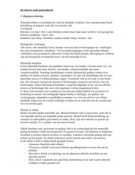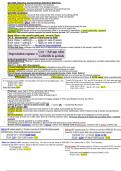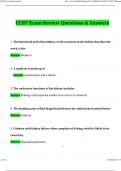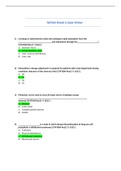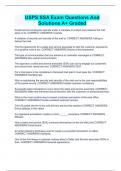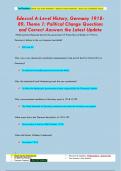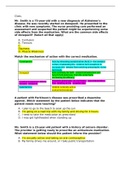LES 4
Hypothesis Testing on a single parameter
1
,Hypothesis Testing on multiple parameters
1. Testing whether 2 parameters are equal to one another
β p=β q
Y¿ α + β 1 X 1 + β 2 X 2+ u
H 0 : β 1=β 2 ⇔ β 1−β 2=0
H a : β 1 ≠ β 2 ⇔ β 1−β 2 ≠0
Remember!!!
T-test Difference in parameters EXAMEN
( a ± b )2=a2 +b2 ± 2ab
Difference of two ‘normal distributions’
^β − ^β −0 ^β − ^β −0
p q p q
t= = t (df =N −k )
√ σ^ 2
β p−β q √ σ^ 2
βp + σ^ 2β −2 σ^ β
p p βq
F-test Difference in terms (Linear Restriction)
Y =α + β 1 X 1+ β 2 X 2 +u B2 vervangen door B1
Under de H0 kan ik
⇒Y =α + β1 X 1 + β 1 X 2 +u “under the Null”
een model schatten
⇔ Y =α + β1 ( X 1 + X 2) + u
If the Linear Restriction holds in reality; both models should perform the same… in other
words; same Sum of Squared Residuals = H0
Y =α + β 1 X 1+ β 2 X 2 +u ≅ Y =α + β1 ( X 1 + X 2 ) +u
F-test: comparing SSR
F-tests are based on differences in the Sum of Squared Residuals
Remember that SSR is actually the “unexplained part of the variance in the
dependent variable”
SSR is minimized by OLS
SSR is ‘lack of fit’
2 SSR
R =1− , which is ‘Model Fit’
SST
Basically, we compare how well two models fit the data
Unrestricted model “as it is” SS Ru
Restricted model “under the Null” SS Rr
m = number of restricted
SS Rr −SS R u parameters
m
F= F ( m; N−k )
SS Ru
N−k“too much” from each other, the Restriction will
If the ‘Model Fits’ deviate
probably not be true Reject H 0
“too much” is determined using F-test: hoe extreme is het wat we hebben
berekend? Kijk waar de F-verdeling ongeveer op de curve ligt?
A particular H0: all coefficients are equal to 0
Example
2
, Zijn de 2 waarden aan
mekaar gelijk?
P-waarde zeer klein dus
H0 verwerpen: zie je ook
heel duidelijk
2. Testing whether the sum (or difference) of 2 parameters is
equal to a specified value β p + β q=k
2-Parameter restriction
Cobb-Douglas Production Function
β1 β2 u
Y = β0 X 1 X 2 e ⇔ lnY =α + β 1 ln X 1+ β 2 ln X 2 +u
Constant Returns to Scale? H 0 : β 1+ β 2=1
T-test Approach
^β p + β^ q −k ^β 1+ ^β 2−1
t= = t (df =N −k )
√ σ^ 2
βp −βq √ σ^ 2
β1
2
+ σ^ β +2 σ^ β
2 1 β2
F-test Difference in terms (Linear Restriction)
lnY =α + β 1 ln X 1 + β 2 ln X 2 +u
⇒lnY =α + β 1 ln X 1+(1−β ¿¿ 1) ln X 2+u ¿ “under the Null”
⇔ lnY =α + β 1 ln X 1+ ln X 2−β 1 ln X 2 +u
⇔ lnY −ln X 2=α + β 1 ( ln X 1−ln X 2 ) +u (dit is het nieuwe restrictie model)
If the Linear Restriction holds in reality; same Sum of Squared Residuals
3
Hypothesis Testing on a single parameter
1
,Hypothesis Testing on multiple parameters
1. Testing whether 2 parameters are equal to one another
β p=β q
Y¿ α + β 1 X 1 + β 2 X 2+ u
H 0 : β 1=β 2 ⇔ β 1−β 2=0
H a : β 1 ≠ β 2 ⇔ β 1−β 2 ≠0
Remember!!!
T-test Difference in parameters EXAMEN
( a ± b )2=a2 +b2 ± 2ab
Difference of two ‘normal distributions’
^β − ^β −0 ^β − ^β −0
p q p q
t= = t (df =N −k )
√ σ^ 2
β p−β q √ σ^ 2
βp + σ^ 2β −2 σ^ β
p p βq
F-test Difference in terms (Linear Restriction)
Y =α + β 1 X 1+ β 2 X 2 +u B2 vervangen door B1
Under de H0 kan ik
⇒Y =α + β1 X 1 + β 1 X 2 +u “under the Null”
een model schatten
⇔ Y =α + β1 ( X 1 + X 2) + u
If the Linear Restriction holds in reality; both models should perform the same… in other
words; same Sum of Squared Residuals = H0
Y =α + β 1 X 1+ β 2 X 2 +u ≅ Y =α + β1 ( X 1 + X 2 ) +u
F-test: comparing SSR
F-tests are based on differences in the Sum of Squared Residuals
Remember that SSR is actually the “unexplained part of the variance in the
dependent variable”
SSR is minimized by OLS
SSR is ‘lack of fit’
2 SSR
R =1− , which is ‘Model Fit’
SST
Basically, we compare how well two models fit the data
Unrestricted model “as it is” SS Ru
Restricted model “under the Null” SS Rr
m = number of restricted
SS Rr −SS R u parameters
m
F= F ( m; N−k )
SS Ru
N−k“too much” from each other, the Restriction will
If the ‘Model Fits’ deviate
probably not be true Reject H 0
“too much” is determined using F-test: hoe extreme is het wat we hebben
berekend? Kijk waar de F-verdeling ongeveer op de curve ligt?
A particular H0: all coefficients are equal to 0
Example
2
, Zijn de 2 waarden aan
mekaar gelijk?
P-waarde zeer klein dus
H0 verwerpen: zie je ook
heel duidelijk
2. Testing whether the sum (or difference) of 2 parameters is
equal to a specified value β p + β q=k
2-Parameter restriction
Cobb-Douglas Production Function
β1 β2 u
Y = β0 X 1 X 2 e ⇔ lnY =α + β 1 ln X 1+ β 2 ln X 2 +u
Constant Returns to Scale? H 0 : β 1+ β 2=1
T-test Approach
^β p + β^ q −k ^β 1+ ^β 2−1
t= = t (df =N −k )
√ σ^ 2
βp −βq √ σ^ 2
β1
2
+ σ^ β +2 σ^ β
2 1 β2
F-test Difference in terms (Linear Restriction)
lnY =α + β 1 ln X 1 + β 2 ln X 2 +u
⇒lnY =α + β 1 ln X 1+(1−β ¿¿ 1) ln X 2+u ¿ “under the Null”
⇔ lnY =α + β 1 ln X 1+ ln X 2−β 1 ln X 2 +u
⇔ lnY −ln X 2=α + β 1 ( ln X 1−ln X 2 ) +u (dit is het nieuwe restrictie model)
If the Linear Restriction holds in reality; same Sum of Squared Residuals
3


